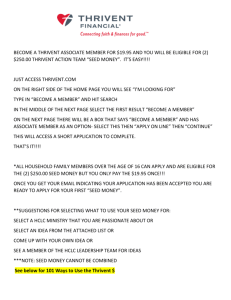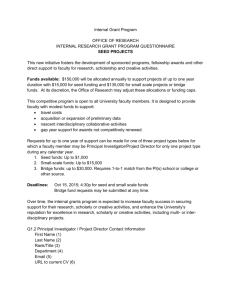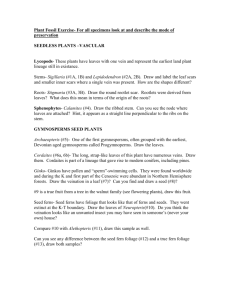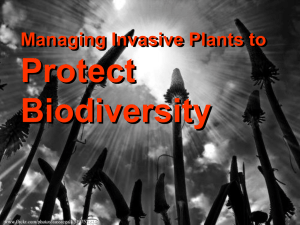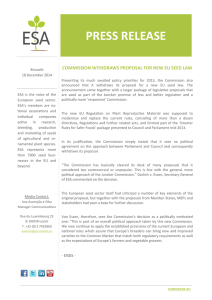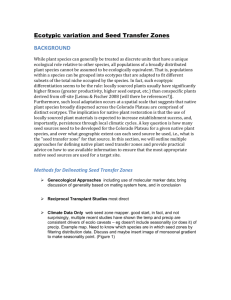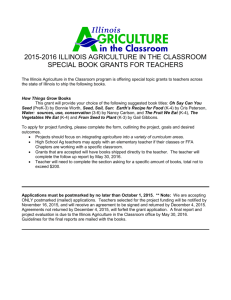animals, Plants, and Their Environment
advertisement
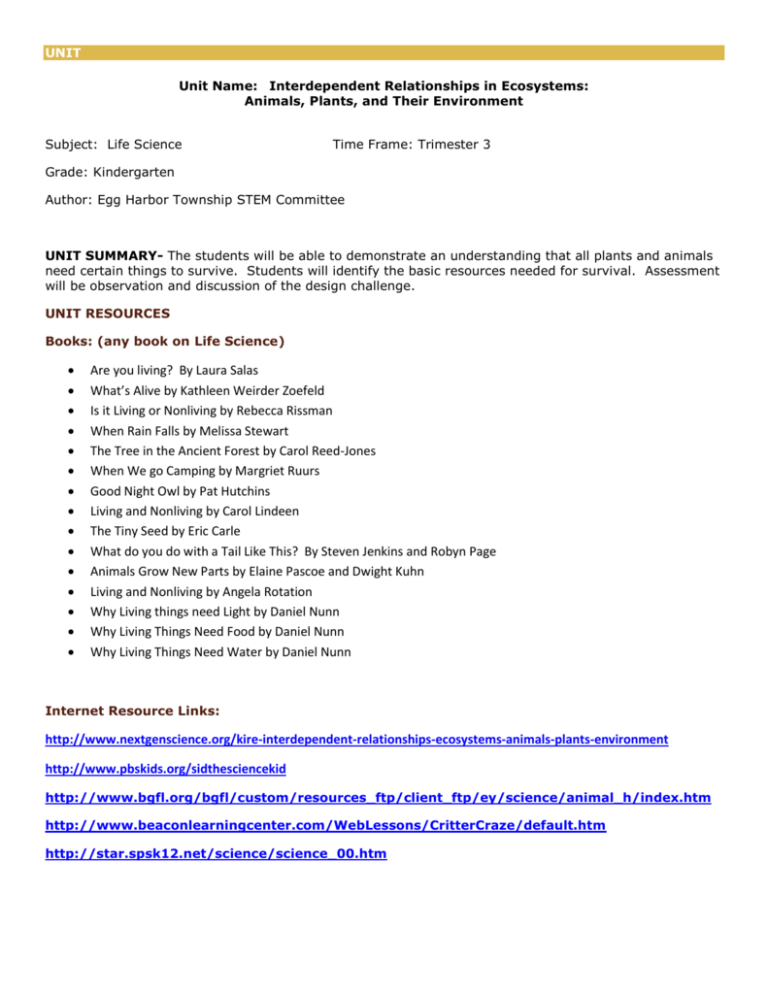
UNIT Unit Name: Interdependent Relationships in Ecosystems: Animals, Plants, and Their Environment Subject: Life Science Time Frame: Trimester 3 Grade: Kindergarten Author: Egg Harbor Township STEM Committee UNIT SUMMARY- The students will be able to demonstrate an understanding that all plants and animals need certain things to survive. Students will identify the basic resources needed for survival. Assessment will be observation and discussion of the design challenge. UNIT RESOURCES Books: (any book on Life Science) Are you living? By Laura Salas What’s Alive by Kathleen Weirder Zoefeld Is it Living or Nonliving by Rebecca Rissman When Rain Falls by Melissa Stewart The Tree in the Ancient Forest by Carol Reed-Jones When We go Camping by Margriet Ruurs Good Night Owl by Pat Hutchins Living and Nonliving by Carol Lindeen The Tiny Seed by Eric Carle What do you do with a Tail Like This? By Steven Jenkins and Robyn Page Animals Grow New Parts by Elaine Pascoe and Dwight Kuhn Living and Nonliving by Angela Rotation Why Living things need Light by Daniel Nunn Why Living Things Need Food by Daniel Nunn Why Living Things Need Water by Daniel Nunn Internet Resource Links: http://www.nextgenscience.org/kire-interdependent-relationships-ecosystems-animals-plants-environment http://www.pbskids.org/sidthesciencekid http://www.bgfl.org/bgfl/custom/resources_ftp/client_ftp/ey/science/animal_h/index.htm http://www.beaconlearningcenter.com/WebLessons/CritterCraze/default.htm http://star.spsk12.net/science/science_00.htm STAGE ONE GOALS AND STANDARDS K-LS1-1. Use observations to describe patterns of what plants and animals (including humans) need to survive. [Clarification Statement: Examples of patterns could include that animals need to take in food but plants do not; the different kinds of food needed by different types of animals; the requirement of plants to have light; and, that all living things need water.] ENDURING UNDERSTANDINGS All animals need food in order to live and grow. They obtain their food from plants or from other animals. Plants need water and light to live and grow. (K-LS1-1) Scientists look for patterns and order when making observations about the world. (K-LS1-1) Patterns in the natural and human designed world can be observed, used to describe phenomena, and used as evidence. (K-LS1-1) Plants and animals are dependent on the natural resources of where they live. KNOWLEDGE AND SKILLS Vocabulary (Vocabulary is not assessed and is to be used by teacher as needed) Patterns – The regular or repeated way in which something happens or is done Plants – A living thing that grows in the ground, usually has leaves or flowers, and needs sun and water to survive Animal – Any living thing that is not a plant Recycle – To use (something) again; To make something new from something that has been used before Habitat – The place or type of place where a plant or animal naturally or normally lives or grows Resource – A place or thing that provides something useful Wants – To desire or wish for something Needs – Something that a plant or animal must have in order to live and/or thrive Hypothesis – A guess or theory Students will: determine the resources necessary for the survival of a living thing. use tools and materials to investigate the different needs of living things. use and share ideas and observations of different survival needs. identify patterns and order when making observations about the world. STAGE TWO PERFORMANCE TASKS Use recycled materials to house your plant or flower seed (note: bean plants grow the fastest). Provide each group of students a seed and a choice of housing for their seed. Materials: Recycled containers to house the seed. Seeds Soil Water Paper Towels Measuring Tools (to add water) Directions: Students will work in small groups to plant and care for their seed. Students will record data about the care and growth of their plant. OTHER EVIDENCE Formative Assessments: Teacher questions Class discussions Related Math/STEM activities Related English Language Arts activities Student created graphs Recorded information about measureable attributes (ex: amount of water and/or sunshine, growth of plant, etc.) STAGE THREE LEARNING PLAN Activities, experiences, and lessons: April/May –Discuss living things (plants and animals) and their required resources and needs. Identify living things and discuss or read about their needs May/June – Plant a seed and record observations of its growth Students will work in small groups: o Group will choose a container (ex: milk carton, soda bottle, plastic bag, cup, etc.) for their seed o Group will hypothesize* the best location for their plant, the amount of water their plant needs, and how often it needs to be watered. o Group will record the amount of water and how often they water the plant. o Group will document the growth of their plant through journal writing and graphing. o Groups will compare and discuss their data, hypothesis*, and conclusions. *Emphasize the understanding that a hypothesis is simply a guess (as per the Scientific Method) to be proven right or wrong. Students should be encouraged to learn from their mistakes and understand that mistakes foster other discoveries. Mistakes aren’t always a bad thing! Check this link to see some inventions that were created from mistakes. http://www.businessinsider.com/these-10-inventions-were-made-by-mistake-2010-11 Common Core State Standards Connections: ELA/Literacy – R.K.1 W.K.1 W.K.2 W.K.7 SL.K.5 With prompting and support, ask and answer questions about key details in a text. (K-ESS2-2) Use a combination of drawing, dictating, and writing to compose opinion pieces in which they tell a reader the topic or the name of the book they are writing about and state an opinion or preference about the topic or book. (K-ESS2-2) Use a combination of drawing, dictating, and writing to compose informative/explanatory texts in which they name what they are writing about and supply some information about the topic. (K-ESS2-2),(K-ESS3-3) Participate in shared research and writing projects (e.g., explore a number of books by a favorite author and express opinions about them). (K-LS1-1) Add drawings or other visual displays to descriptions as desired to provide additional detail. (K-ESS3-1) Mathematics – MP.2 MP.4 K.CC K.MD.A.2 Reason abstractly and quantitatively. (K-ESS3-1) Model with mathematics. (K-ESS3-1) Counting and Cardinality (K-ESS3-1) Directly compare two objects with a measurable attribute in common, to see which object has “more of”/”less of” the attribute, and describe the difference. (K-LS1-1)



